#amblyrhynchus cristatus
Explore tagged Tumblr posts
Text

A marine iguana (Amblyrhynchus cristatus) basks on lava rock in the Galapagos Islands, Ecuador
by Anton
#marine iguana#iguanas#lizards#reptiles#amblyrhynchus cristatus#amblyrynchus#iguanidae#squamata#reptilia#chordata#wildlife: ecuador#wildlife: south america
1K notes
·
View notes
Text
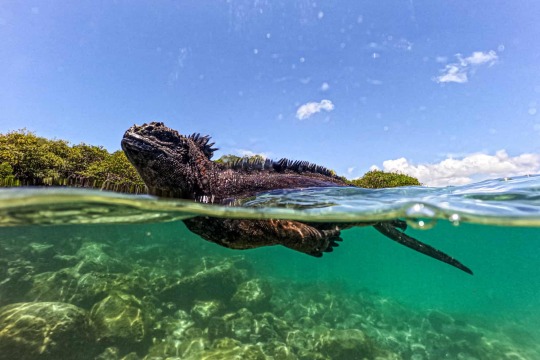
Santa Cruz Island, Ecuador
A marine iguana (Amblyrhynchus cristatus) swimming in Tortuga Bay, part of the Galapagos archipelago. Greenpeace has called for the creation of a high seas marine protected zone under a new UN treaty to secure a much wider area around Ecuador’s Galapagos archipelago
Photograph: Ernesto Benavides/AFP/Getty Images
#ernesto benavides#photographer#afp via getty images#santa cruz island#ecuador#marine iguana#iguana#reptile#amblyrhynchus cristatus#tortuga bay#galapagos archipelago#nature
62 notes
·
View notes
Text
A iguana-marinha (Amblyrhynchus cristatus) é o único lagarto do mundo com hábitos marinhos e é uma das muitas extraordinárias espécies que só se encontram no arquipélago de Galápagos.
#animal#animais#animals#biologia#biology#iguana#marine iguana#amblyrhynchus cristatus#lizard#lagarto#reptil#reptile#galapagos#ocean#oceano#sea#mar
23 notes
·
View notes
Text
daily? animal?
marine iguana (Amblyrhynchus cristatus)
i might draw an animals every day.. maybe...


#daily? animal?#reptile#lizard#iguana#marine iguana#amblyrhynchus cristatus#i know i spelled the genus name wrong but my sketchbook is in the other room now and im not retaking it#my art#sketch#pencil#in retrospect i sort of messed up the second one's skull shape a bit#the wikimedia pic i used as reference for the second one was an iguana that just looked SUPER pissed#i didnt do it justice#if you search marine iguana on wikimedia commons and scroll a bit youll see what i mean
5 notes
·
View notes
Text
Off the western coast of Ecuador in South America resides one of Earth's strangest and newest ecosystems, the Galapagos islands. This collection of 20 islands rose from the sea about five million years ago due to volcanic activity in the Pacific, and the creatures that colonized it quickly radiated to fill the brand new niches. One such species, a lizard, took a path that no other lizard had since the time of the dinosaurs. While its brethren colonized the land or debased themselves to become car insurance mascots, this lizard dove snout-first into the sea. Yet, it has begun to struggle due to the ways in which humans have modified the oceans, and this awesome lizard species is now at risk of extinction. Consider: the marine iguana, Amblyrhynchus cristatus..
2 notes
·
View notes
Text
Mr. Bynoe, however, found a piece of crab in one; but this might have got in accidentally, in the same manner as I have seen a caterpillar, in the midst of some lichen, in the paunch of a tortoise.
"Journal of Researches into the Natural History and Geology of the Countries Visited During the Voyage of H.M.S. Beagle Round the World, 1832-36" - Charles Darwin
#book quote#the voyage of the beagle#charles darwin#nonfiction#galapagos islands#benjamin bynoe#marine iguana#amblyrhynchus cristatus#crab#stomach contents#caterpillar#lichen#paunch#tortoise
2 notes
·
View notes
Text

3x Penguin + 1x Iguana (b / b) [4 / 4]
A trio of Galapagos penguins flank a marine iguana over a rocky outcrop on the shore of Las Tintoreras off Isla Isabela, Galapagos.
HDR put together with Photomatix, panorama put together with Luminar.
#Panasonic#Lumix#TZ-5#Isla Isabela#Isabela#Galapagos#Ecuador#fauna#penguin#iguana#Spheniscus mendculus#Amblyrhynchus cristatus#HDR#Photomatix#Panorama#Luminar
0 notes
Text
The Amblyrhynchus, a remarkable genus of lizards, is confined to this archipelago: there are two species, resembling each other in general form, one being terrestrial and the other aquatic. This latter species (A. cristatus) was first characterized by Mr. Bell, who well foresaw, from its short, broad head, and strong claws of equal length, that its habits of life world turn out very peculiar, and different from those of its nearest ally, the Iguana.

"Journal of Researches into the Natural History and Geology of the Countries Visited During the Voyage of H.M.S. Beagle Round the World, 1832-36" - Charles Darwin
#book quotes#the voyage of the beagle#charles darwin#nonfiction#galapagos islands#amblyrhynchus#amblyrhynchus cristatus#lizards#marine iguana#thomas bell#peculiar
0 notes
Text

Santa Cruz Marine Iguana (Amblyrhynchus cristatus), EAT TASTY SEE WEED!!!, family Iguanidae, Galapagos
photograph by Brooke Pyke
4K notes
·
View notes
Text

Galapagos Lava Lizard (Microlophus albemarlensis), family Tropiduridae, sitting on a Marine Iguana (Amblyrhynchus cristatus), family Iguanidae, Fernandina Island, Galapagos
photographs by Rachelle Mackintosh
696 notes
·
View notes
Text

Marine iguana (Amblyrhynchus cristatus)
Reptiles and Amphibians of the World. Written by Hans Hvass. Illustrated by Wilhelm Eigener. Originally published in 1958.
Internet Archive
272 notes
·
View notes
Text
I haven't talked reptiles in Wet Beast Wednesday in a while (and the first time I did it got like 9 notes) so I'll do it again with marine iguanas. Admittedly they're more amphibious than aquatic, but there's no Moist Beast Monday and I think they're cool so it'll have to do.
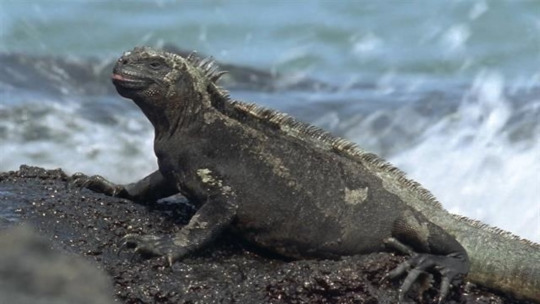
(Image: Doug Jones in The Shape of Water a marine iguana basking on a rock)
Marine iguanas (Amblyrhynchus cristatus) are large lizards native to the Galapagos Islands. They are unique for being the only extant lizards that spend time in the ocean. As of 2017, there are 11 distinct subspecies that are isolated from each other by the islands they live on. Occasionally a member of one subspecies will end up on the wrong island and produce hybrid offspring. Marine iguanas also can but very rarely do hybridize with the land iguanas of the Galapagos, with whom they are believed to share a common ancestor.
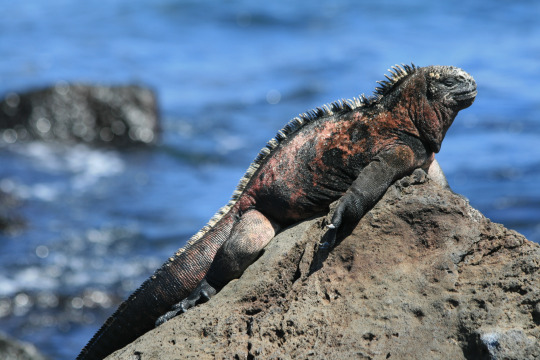
(Image: an iguana perched on a rock
Marine iguanas vary in size based on subspecies, with those from smaller islands reaching a smaller adult size. In general, they race from 12 to 56 cm (4.7 - 22 in) from snout to rear, with a tail ranging from 17 to 84 cm (6.7 - 33.1 in). Males are significantly larger than females, up to twice the weight and noticeably longer. Marine iguanas are robust, with relatively short limbs. Their leg bones are heavy, to provide ballast while swimming. Their tails are laterally flattened and provide propulsion for swimming. They have a row of spines down their backs that provide stability while swimming, similar to a fish's dorsal fin. Their feet have powerful claws and can be used to cling onto and push off of undersea rocks. Marine iguanas were noted by many explorers for their dark color, including Charles Darwin (who referred to them as "clumsy" and "disgusting"). This dark color helps them warm up quickly after diving in the sea.

(image: an iguana going for a swim)
A major feature of the marine iguana is its diet, which is a huge factor in their semiaquatic lifestyle. They feed almost exclusively on green and red algae that grown underwater. To reach the algae, females and smaller males browse the intertidal zone during low tide, while larger males and abnormally large females can swim out to the deeper subtidal zone to forage. They can spend an hour underwater one one breath and dive to 30 m (98 ft), but most dives are much shallower and shorter. Only the largest males swim offshore and dive to significant depths for their food. Because they are positively buoyant, divers must actively swim or cling onto rocks to stay underwater. Most individuals will return to the same spot for feeding and competition over feeding spots have been known to happen. Larger males that swim out for their food have the advantage of less competition for their feeding spots. The species has adapted to be able to fast or subsist on reduced for long periods. During El Nińo, where food supplies can be reduced for years, they will actually shrink, with even their bones getting shorter, then return to full size once the food supply is restored. Because they consume excess salt with their food, marine iguanas have developed the ability to filter the salt out of their blood and expel it through glands in their nostrils. The secreted salt can then be sneezed away. Juveliles spend the first few months of their life feeding on (WARNING: GROSS) the feces of older iguanas. This helps them develop the culture of symbiotic gut bacteria that helps them digest algae. In fact, their digestive systems are so specialized to algae that they can't switch diets.

(image: a marine iguana grazing on algae underwater)
As ectotherms (cold-blooded animals), marine iguanas need to keep themselves warm to survive. The water around the Galapagos is typically around 11-23 degrees C (52-75 F) while their preferred body temp is 35-39 C (95-102 F). This high preferred temperature helps with their digestion. To keep themselves warm, the iguanas spend a lot of their time basking in the sun, especially after swimming. They can also reduce their heart beats while cold to help prevent heat loss. Basking iguanas can cover large beaches. They live in colonies that usually range between 20 and 500 individuals but can sometimes get up to 1000 members. Their biomass to area ratio can be the highest of any reptile. While they are considered gregarious, they display no social behavior such a grooming. The closest they get to a group activity is sleeping next to each other to conserve heat at night. They also get along with other species, such as Darwin's finches, mockingbirds, and crabs who will pick parasites off their skin. Divers may allow cleaner fish to pick off bits of dead skin. Another lizard, the lava lizard, likes to visit colonies to hunt flies attracted to the iguanas. The iguanas allow the much smaller lizards to climb all over them. Marine iguanas often share beaches with Galapagos sea lions, who will occasionally allow the iguanas to climb over them.
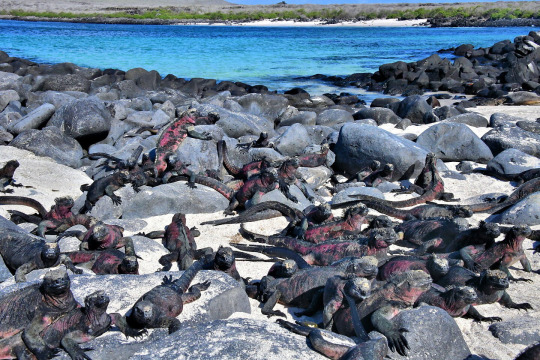
(image: a group of iguanas basking together)
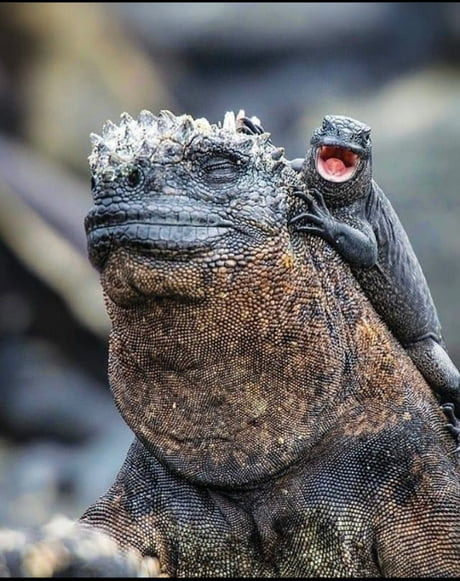
(image: a male marine iguana, identifiable by the rough scales on his head, with a lava lizard climbing on him)
During mating season, male iguanas stop being as chill with their neighbors, attempting to establish a territory and push other males out. They also change from their normal dark appearance to a much brighter coloration. Territories are usually bordered by rocks or crevasses and can be found next to each other in groups. Males will attempt to attract females to their territories while fighting other males to get access to their females. This behavior is called lekking. Females show a distinct preference for larger males and it is the largest males that are most successful at maintaining territories. Medium males are forced to patrol the edges of territories to try to pick up mates while small males often pretend to be female to sneak into another's territory and attempt to mate. Males with territories defend them with special displays where they will raise their dorsal spines and open their mouths while bobbing their heads around. If another male challenges the dominant, they will display at each other. If neither submits, a fight will start. Males fight by headbutting and trying to push each other around. These fights can last for hours and the participants will occasionally take breaks. In most cases, one will eventually display a submissive posture and retreat, though in a few cases the fight has escalated to biting and scratching. When courting a female, a male will nod at her and approach in a sideways walk. Smaller males without territories may also try mating forcibly. Females only mate once per year and will signal rejection to additional suitors by nodding at them.
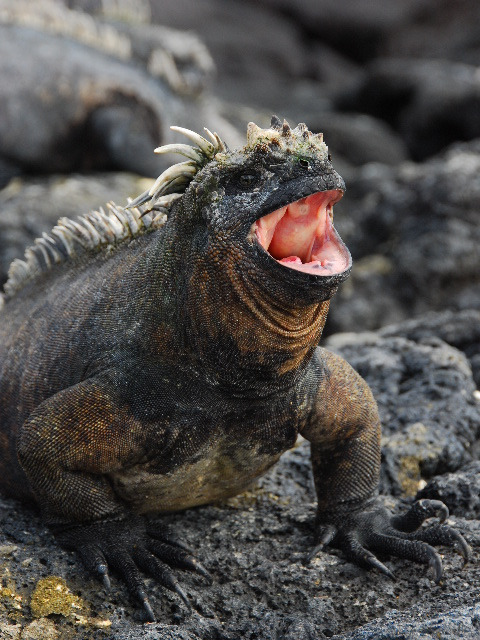
(image: a male performing a territorial display)
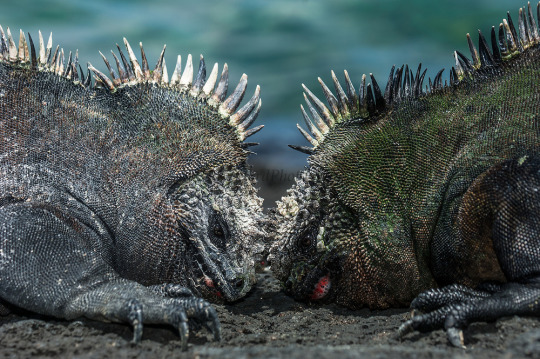
(image: two males headbutting each other in a territorial battle)
Mating season usually lasts between December and March. Females will lay eggs about a month after mating. The eggs (usually 2 to 3 but sometimes up to 6) can collectively weigh up to a quarter of the mother's weight, which is very large for an iguana. They are laid well above the tide line and buried in sand or soil. In places with few good nesting sites, mothers will guard their eggs after hatching to make sure other females don't dig therm up to steal the spot. When females fight over nesting spots they are less disciplined than males and will quickly resort to biting. The eggs hatch after 3-4 months. Females reach sexual maturity after 3-5 years while males do so after 6-8 years. They live an average lifespan of 12 years, but can live up to 60.
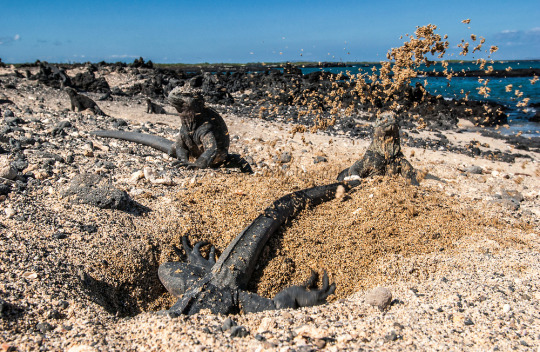
(image: a female iguana digging her nest)
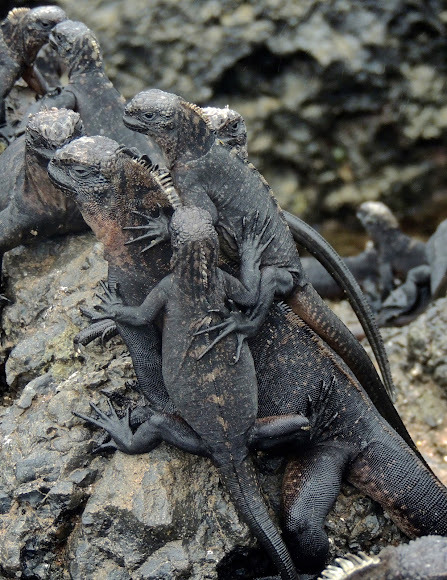
(image: a group of juveniles climbing on each other)
Marine iguanas are classified as vulnerable by the IUCN, while a few populations are instead considered endangered. A major threat to them is warming seas, which can reduce the red and green algae populations and replace them with inedible brown algae, leading to starvation. Marine iguanas only have a few predators and most of them target juveniles or small adults. As a result, the adults demonstrate island tameness, a lack of wariness to potential predators. This has left them vulnerable to predators introduced by humans, such as dogs, cats, rats, and pigs. Despite these invasive predators being present for ver 100 years, they have not developed any anti-predator defenses against them, a phenomenon called ecological naïveté. They also do not fear humans and will allow tourists to approach them, which has led to injuries and the spread of human-introduced diseases. They are protected by laws of Ecuador and most of their range is in protected areas. Efforts to remove invasive predators have seen some benefit. They are difficult to keep in captivity due to their specialized diets, and they have never been bred in captivity.
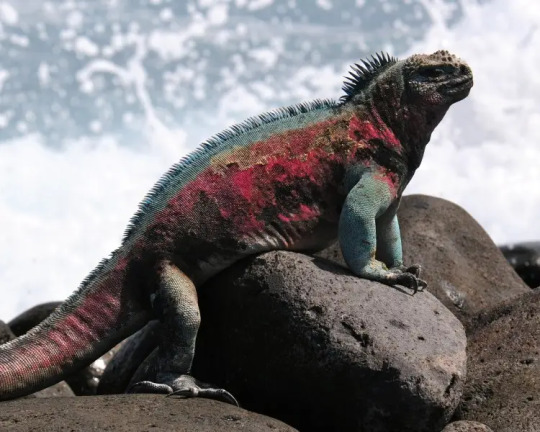
(image: a male with his bright mating season coloration)
#wet beast wednesday#marine iguana#biology#zoology#ecology#marine biology#galapagos#animal facts#iguana#lizard#reptile#long post
210 notes
·
View notes
Text
The taxonomy of Sly Cooper: Part 3
Part 1 Part 2
Sorry for being so late with this one, but I've been occupied with other things.
Anyway, time to overthink the biology of the different members of the Klaww Gang!
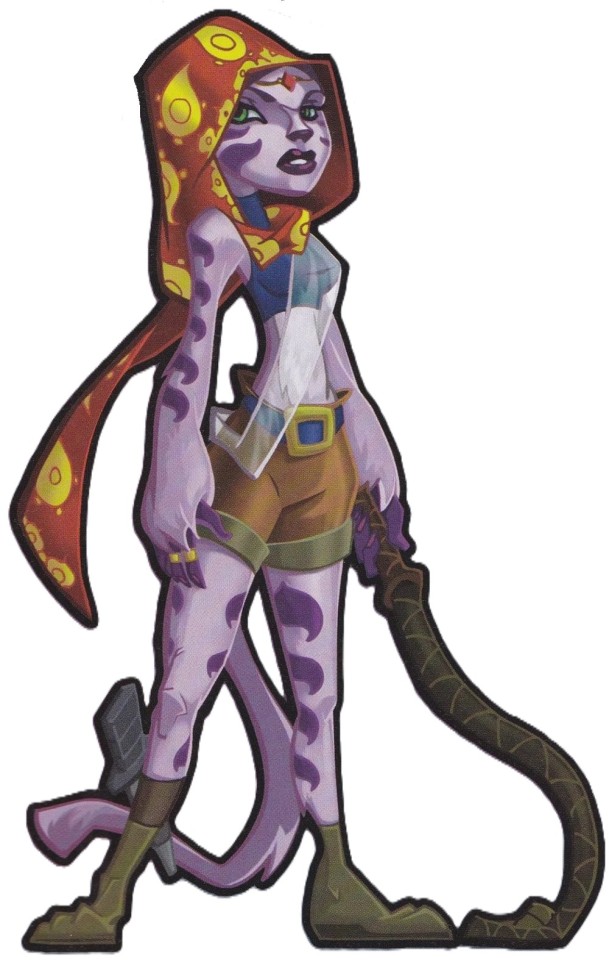

Starting off with a two for one, it's pretty obvious that both Neyla and Rajan are meant to be mainland or bengal tigers (Panthera tigris tigris). They were originally conceived by the developers as father and daughter afterall.

I think pretty much everyone knows what tigers are and what they're all about (solitary apex predators, live in Asia) so I'll spare you the details, and share some lesser known facts about them instead.
Most relevant to the topic at hand, the bengal tiger was long considered a separate subspecies from the siberian, chinese and malayan populations, but recent genetical analysis suggests that they all belong to the same subspecies, and are now collectively referred to as the mainland tiger. The only other extant subspecies being the Sunda Islands or sumatran tiger.
Contrary to what Bentley would have you believe, tigers do NOT have an aversion to water. In fact they are some of the best swimmers among big cats, with the population in the Sundarbans being known to swim between islands in the delta in search of prey.
And contrary to popular belief, there are NOT more tigers in captivity in the US than there are tigers in the wild. @why-animals-do-the-thing has a very well researched series examining the data regarding captive tigers in the US which you can find here.
Sidenote: As a kid I thought that Neyla was supposed to be just a normal (purple) tabby cat. It wasn't until I got older and heard Dimitri's office recordings that I realized she was supposed to be a tiger.

Speaking of Dimitri, he is obviously an iguana of some kind. There are no wild iguanas in France, but i guess his family could have migrated there. Some fans have identified him as a marine iguana (Amblyrhynchus cristatus), but his pointed skull and impressive dewlap beard suggests to me that he belongs to the genus of true iguanas (yes, taxonomy is confusing).
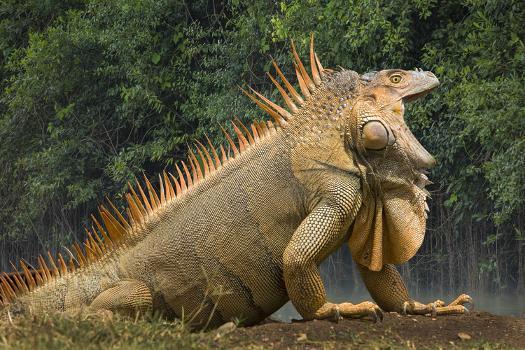
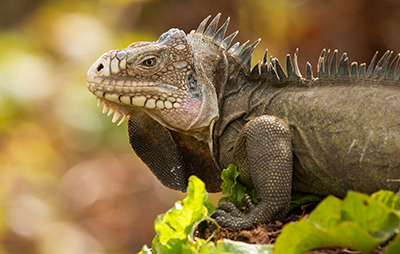
There are two recognised species of the Iguana genus; the green iguana (Iguana iguana) and the lesser antilliean iguana (Iguana delicatissima). I couldn't decide which one fit Dimitri better so you're getting another two for one. Both species grow to be up to six feet long, with males being larger than females. They are herbivorous, and feed on a wide variety of leaves, flowers, seeds and fruits. Both species live in forest and swamp areas, and are very capable swimmers and climbers. In addition to having well-developed vision, iguanas also possess a so-called parietal eye placed at the top of their skull, which allows them to detect ultra-violet light.
The green iguana is by far the most widespread of the two species, being found throughout most of Central America and northern South America, along with invasive populations in Florida and the Carribean. It is also one of the most popular lizards in the pet trade, even though it can be notoriously demanding and stroppy.
By contrast, the lesser antillean iguana is critically endangered, being only found on the archipelago of Lesser Antilles. Here it faces threats from invasive species, such as feral dogs and cats, but its greatest threat is, ironically enough, its invasive cousin the green iguana. The two species compete over resources, and can even interbreed, creating hybrids which further limit the native population.


The Contessa is most likely a black widow spider of the genus Latrodectus, seeing as she's often associated with an hourglass symbol which several members of the genus famously display on their abdomen. There are way too many Latrodectus species to count, so I'm just gonna assume that she is a southern black widow (Latrodectus mactans) which is basically the type species for the genus.
The southern black widow is the most common Latrodectus species in North America, being found throughout the southeastern United States along with Mexico and the Dominican Republic. Like other spiders it largely preys on insects, but sometimes also preys on other spiders, including its fellow species.
Black widows are infamous for their venom, which causes a condition called Latrodectism. This venom is rarely fatal in humans, with fatalities usually being those already of poor health, but it is extremely painful, causing symptons like nausea, vomiting, and muscle pain. These symptoms can sometimes last for weeks.
Black widows are of course also known for practicing sexual cannibalism, where the larger female will consume the male after mating, hence the "widow" name. This is not guaranteed however, as the female may spare the male if she isn't hungry. The females are generally the deadlier of the species though, as they are not only larger, but also have more potent venom (and a longer lifespan). All very fitting for a character who likely poisoned her husband.

As for Jean Bison, I actually like to think that he is a wisent or european bison (Bison bonasus). Part of that is his design. While his head is definitely big, it isn't quite as ridicoulously large as that of an american bison (Bison bison). More importantly however, I think it makes more sense for a european colonizer trying to industrialize the wild north, as opposed to a native american animal.

The european bison is distinquished from its american relative by being generally smaller and lankier in frame, but it is still a large and powerful animal. Adult bulls stand 6 feet tall at the shoulder (taller than the american bison) and can weigh up to 900 kg, making them the largest land animal in all of Europe.
The species has historically had a range covering most of northern Europe, but overhunting and habitat loss drove them to extinction in the wild in the early 20th century. Less than 60 animals remained in zoos worldwide, but thanks to wildlife rehabilitation efforts the species is slowly but steadily recovering. Today they are found in scattered populations across Europe, mostly in the east.
All in all, quite an ironic fit for a villain who's goal involves destroying the natural environment.
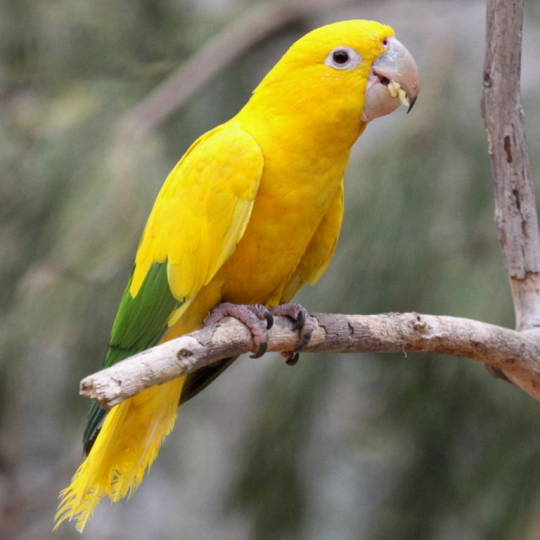


And finally we have Arpeggio. I had a hard time choosing between two particular species for him; the yellow faced parrot (Alipiopsitta xanthops), and the golden parakeet (Guaruba guarouba). Thanks to @arpeggio-the-parrot for coining me in on that last one. The yellow-faced has a more appropriate plumage, but the parakeet has a more prominent beak, much like Arpeggio. This combined with features we'll discuss later makes me conclude that he must be a golden parakeet. I do also kinda like the idea of him being a flightless kakapo, but I digress.
The golden parakeet or golden conure is only found in the Amazon Basin of northern Brazil. The species is endangered in the wild due to deforestation and the pet trade. It has a diet largely consisting of fruits and seeds, particularly corn. This is a highly social species, with up to 10 individuals roosting in the same tree hole. Different females will lay their eggs in a single nest, and when the chicks hatch they are raised communally.

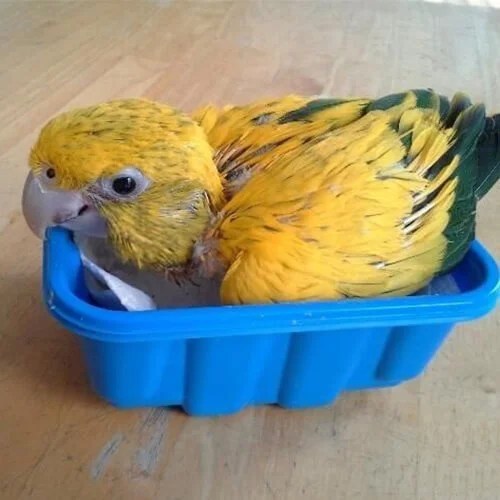
The golden parakeet might seem like an odd choice, given that adults of the species are almost entirely yellow, (besides their green remige flight feathers) as opposed to Arpeggio's more balanced mix of yellow and green. However, juvenile parakeets have more prominently green coloring, including their back and tail feathers, which they lose as they grow older. This to me suggests, that Arpeggio likely suffers from paedomorphism (the retention of juvenile traits into adulthood), which would also explain his underdeveloped wings, that are so key to his character. Funny how things work out like that.
17 notes
·
View notes
Note
“Pumas aren't even in the same genus of lions there's literally no way for them to reproduce and make cubs. Whoever made that suggestion is dumb "
i cannot stand people who don’t know basic shit about science i’m BEGGING yall to understand that scientific rules are not all size fits one jesus christ. Yes, typically it is much harder for two animals in separate genus to breed but it is NOT impossible and saying that it is just shows that you don’t know shit about advanced biology. it is okay to not know something but stop being so wrong so loud please. There is a name specifically for hybrids of two separate genus, they’re called intergenetic hybrids.
Known hybrids
-Pumapard (Puma concolor + Panthera pardus)
-beefalo (Bos taurus + Bison Bison)
-Caraval/servical (Caracal caracal + Leptailurus serval)
-dogxim (or Graxorra)
-chinese false-eyed turtle (Cuora trifasciata + Sacalia quadriocellata)
-Hybrid Iguana (cross between Amblyrhynchus cristatus and Conolophus subcristatus)
-Savannah and bengal cats (Hybrids of Leptailurus serval and Prionailurus bengalensis respectively with domestic cats, Felis catus)
-Ursid hybrids, so most bears of different genus can interbreed excluding giant pandas
-Yakolo (Bos grunniens + Bison bison)
-wholpin (Tursiops truncatus + Pseudorca crassidens)
-tiger trout (Salmo trutta × Salvelinus fontinalis)
sorry if this was too aggressive but PLEASE don’t call people dumb when you’re being a fucking idiot 🙏 it is common fucking sense to use google guys.
.
7 notes
·
View notes
Text
Godzilla of the Galápagos: Evolution and Unique Adaptations of Marine Iguanas
Marine iguanas, also known as Amblyrhynchus cristatus, are a fascinating species found exclusively in the Galápagos Islands. They are famous for their ability to live and forage in the sea, making them a unique member of the iguana family. Evolution and Adaptation: From Land to Sea Many biologists believe marine iguanas evolved from land iguanas but adapted significantly to the marine…

View On WordPress
4 notes
·
View notes
Text

There is a black sheep in ever family (or genus). Behold, the marine iguana (Amblyrhynchus cristatus). This lizard inhabits the Galapagos Islands and grows to around 0.6 (female) to 1.3 m long (male). They have a very unusual diet compared to their mainland counterparts: marine algae. In order to get at their favorite food these animals have become the only lizards to dive in saltwater, they can hold their breath for 30-40 minutes at a time and use an undulating body movement to push themselves through the water. Feeding in this environment presents some unique challenges for a endothermic creature, after feeding underwater the iguanas must sunbathe on the dark volcanic rocks that make up the shore of the islands to regain the heat to create energy. They also spit excess salt of their nasal glands with surprising force, sending wads of salty discharge quite high in the air. The also tend to sunbathe in large groups so vast clusters of these large, sneezing, punk-rock aesthetic animals are not a rare sight on the shores of the Galapagos Islands.
#marine biology#marine life#marine animals#ocean animals#marine zoology#ocean#oceanlife#ocean life#sea creatures#lizard#squamatine#reptile#chordata#wet beast wednesday#aquatic animals#sea animals#animal facts#animalia#aquatic
24 notes
·
View notes